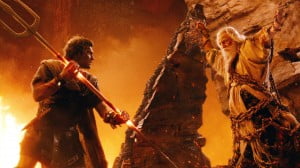
By Susan JAMES
If you liked the 2010 movie, “Clash of the Titans,” you’re going to love “Wrath of the Titans.” The general storyline for the new Warner Bros. film simply substitutes the monstrous Kronos, a gigantic Titan built of fire and lava rising out of the earth, for the monstrous Kraken thrashing up out of the sea. On this second outing of the Perseus myth, Jonathan Liebesman has replaced Louis Leterrier at the director’s helm but his ship is sailing much the same course.
A decade has passed since demigod Perseus, son of Zeus, defeated the Kraken. During that time he’s married, had a son, Helius (John Bell), buried his wife and lived as a simple fisherman in an unnamed Greek village. The village is populated by a crowd of rustics who don’t wash, speak in a variety of clashing accents and look confused when mythological events overtake their village. Do they know that a demigod walks among them? They find out the day strange and evil beasts start falling from the sky and destroy the village.
Zeus has turned up in Perseus’ rustic hut to explain that because mankind has ceased to pray to the gods, the gods are losing their power. A plot is afoot to free the last of the Titans, Kronos, from his imprisonment in Tartarus, a mystical stronghold located in Hades’ realm of the Underworld. Doting father Zeus has come to ask his son for help in foiling this dastardly plot. Son sullenly refuses. But Armageddon waits for no man and soon fireballs and falling beasts convince Perseus to take off on his appointed mission to save the world.
What follows are a string of battle scenes shot so tightly in 3D that those who get motion sickness are warned here not to watch. In a plotline as thin as a shoestring, Perseus joins forces with Andromeda, queen of Greece (Rosamund Pike), who looks fetching in tumbled blond locks and leather kilt, and Agenor (Toby Kebbell), demigod son of Poseidon. Arrayed against them are the forces of Zeus’ disaffected brother Hades (Ralph Fiennes), Perseus’ half brother Ares (Edgar Ramirez) and all the creepy-crawlies that the special effects department could create.
What damages the movie as much as its feeble plot is the weakness of its lead actor. Sam Worthington may have made a worthy Jake Sully in “Avatar,” where a grim expression was mandatory, but here it’s impossible to tell what Perseus is feeling because grim has such a narrow emotional range. Poor Perseus – torn between his two natures, one as a god, one as a man – is facially paralyzed. Is he happy or sad? Impossible to tell. He can fight giant monsters and soar through the air on a flying horse but expressing emotion is apparently not what demigods do.
The questionable caliber of some of the CGI images also affects the movie. When compared to Harry Potter’s memorable ride on a flying hippogriff over a Highland lake in “Harry Potter and the Prisoner of Azkaban,” Perseus riding Pegasus into the mouth of the Titan looks startlingly unconvincing. And with four credited writers and dozens of special effects crew, the audience has the right to be convinced.
See you at the movies!
